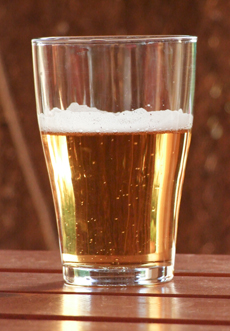Beer Glossary: A Glossary Of The Different Beer TypesPage 8: Types Of Beer Terms & Definitions for the terms From T To Z This is Page 8 of an 8-page article. Click on the red links below to visit other pages. This glossary is protected by copyright and cannot be reproduced in whole or part. You are welcome to link to it. Note that there are many hundreds of official beer styles. To see the full list, visit The Brewers Association.
|
 Wheat beers are lighter in color and taste. Photo by D. Cubillas | SXC. |
|
| TRAPPIST Trappists are an order of monks who own five breweries in Belgium and one in The Netherlands. They produce strong (6% to 12% alcohol), top-fermenting brews. By law they have exclusive right to use the term “Trappist” in marketing their products. The generic term for beers made by monks of other orders is abbey-style. |
||
| TRIPLE or TRIPEL A tripel, or triple in English, is a style of Belgian beer that is a strong, pale ale. The term “triple” refers to the brewing process, in which up to three times the amount of malt is used than in a standard “simple” abbey-style beer. Traditionally, triples are bright yellow to gold in color, a shade or two darker than the average Pilsener. |
||
| TRIPPLE BOCK Not related to tripel, above, tripple bock is a the most intense, highest alcohol bock beer, with alcohol levels up to 30% ABV (60 proof). Bock beer is strong, dark sweet, heavy beer, brewed from barley malt. More about triple bock beer. See also bock and double bock. |
||
| TURBID A cloudy beer. Turbidity is the cloudiness or haziness of a fluid caused by large numbers of individual particles that are generally invisible to the naked eye. Before the invention of filtration in 1878, most beers were turbid. In German, the term is naturtrüb, meaning naturally turbid’. |
||
| VIENNA BEER Originating in Vienna, Austria, Vienna beer is a very sweet, lightly hopped, light-bodied beer. |
 Sam Adams Utopias, a triple bock beer. Photo courtesy Boston Brewing Company. |
|
| WEISSE or WEISSBIER or WEIZENBIER or WITBIER Weissbier is the German word for white beer, a pale brew made from wheat. Weizenbock, a bock beer made from wheat, is sometimes served as a Christmas beer. It is one of the world’s oldest beer styles, typically two parts wheat malt to one part barley malt, which creates a light-bodied beer, about 4% to 5% alcohol. The Dutch/Flemish (Belgian) term for Weissbier is witbier. Belgian witbieren (the plural of witbier) often are brewed with spices such as coriander, or fruits such as bitter orange peel, giving them slightly fruity nuances. In Germany, there are two styles: Weizen in the western and northern regions and Weissbier or Weisse in Bavaria. See also Berliner Weisse, Gruut, Hefeweizen, Lambic and Kristallweizen. Weissbier is popularly paired with Weisswurst (white sausage), a fresh, mildly spiced pork and veal sausage. |
||
| WEIZENSTARKBIER A high-alcohol wheat beer. |
||
| WHITE ALE An unfiltered Belgian-style spiced ale, pale and cloudy. As a crisp white ale, it has a high level of wheat, and sometimes oats. The spices typically include orange peel and coriander, with other fruits, spices or herbs added by the brewmaster. At bars and restaurants, it is sometimes served with a lemon wedge. |
||
| WHEAT BEER A beer that is brewed with a significant proportion of wheat, which provides a distinctive pale color, creamy texture and a light, sweet flavor. Some have overtones of banana and clove. The best-known wheat beers are Belgian witbier and German Weissbier. See Weisse.
|
 Wheat beer served with baby Swiss, Gruyère and pretzels. Photo courtesy of Wisconsin Milk Marketing Board. |
|
| WORT The fermentable sugars made from the mash. See beer-making for the entire process of beer-making. |
||
| YEAST Yeast cells love to eat sugar. In doing so, they cause the wort (the sweet liquid from the water and heated grains) to ferment, which produces alcohol and carbon dioxide. Yeast also imparts flavor and can be used to give a fruity taste to beer. |
||
| ZYMURGY The science or study of fermentation. Go To The Article Index Above Some terms in this glossary are © 2005 National Beer Wholesalers Association. All rights reserved. Other content is © Lifestyle Direct Inc. All rights reserved. |
||
© Copyright 2005-2026 Lifestyle Direct, Inc. All rights reserved. All images are copyrighted to their respective owners.